BVV (Ok to Discount)

5L Solvent Pro Rotary Evaporator Bump Trap
5L Solvent Pro Rotary Evaporator Bump Trap Replacement Bump Trap for 5L Solvent Pro Rotary Evaporator
$400.00
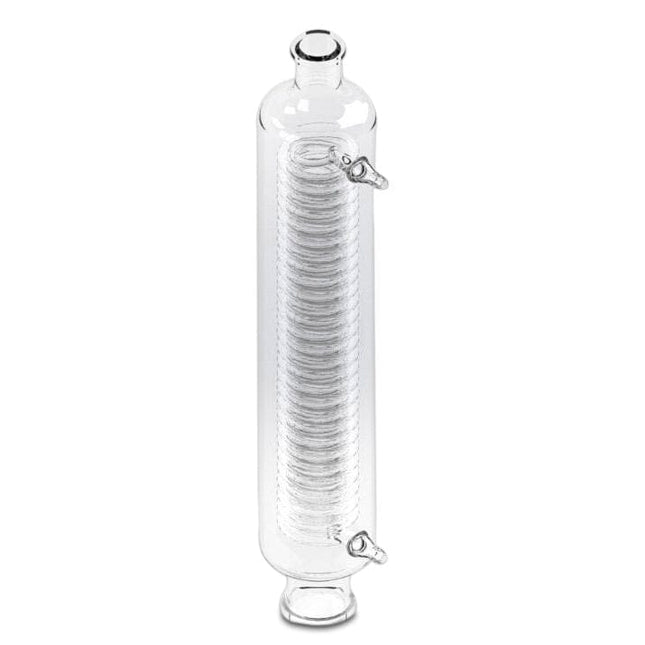
10L Solvent Pro Rotary Evaporator Main Condenser
10L Solvent Pro Rotary Evaporator Main Condenser 10L Solvent Pro Rotary Evaporator Main Condenser *Notice to customers: All units are inspected for broken glassware or parts before leaving BVV™. If the unit arrives damaged (this does not include minor imperfections or scuffs in glassware), the customer MUST contact BVV™ within 72 hours from carrier delivery to file a claim. If the customer DOES NOT contact BVV™ within 72 hours from carrier delivery, then BVV™ cannot issue any replacement(s) or compensation for the item; a new purchase will need to be made for a replacement.
$350.00
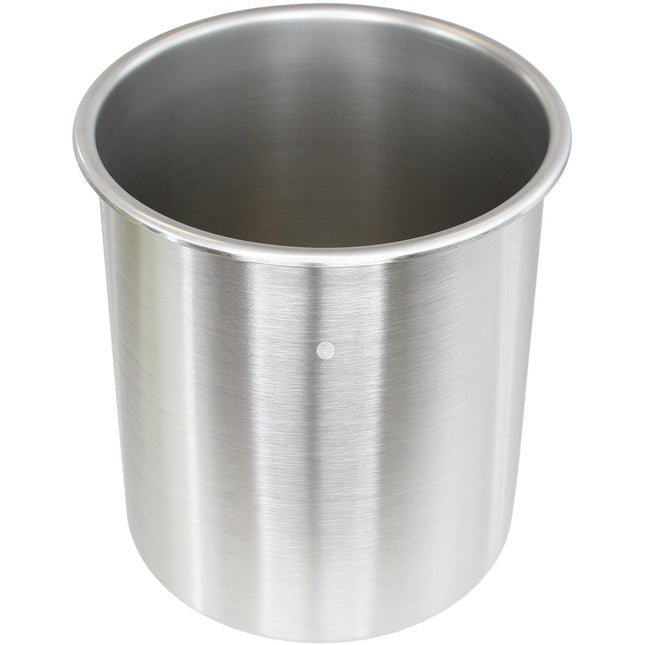
1.5 Gallon Tall Stainless Steel SIDEMOUNT - POT ONLY
1.5 Gallon Tall Stainless Steel SIDEMOUNT - POT ONLY ***Note: 'with Hardware' Option only includes the side-mount manifold with gauge pre-installed. (Does Not Include Lid or Gasket) This is a replacement part for the following Vacuum Chambers: Glass Vac 1.5 Gallon Tall Stainless Steel Vacuum Chamber Dimensions: 8-5/8"" Tall x 7-1/8"" Diameter Hole Size: 21/64 Material: 304 - 2B Stainless Steel
$58.00 - $70.00
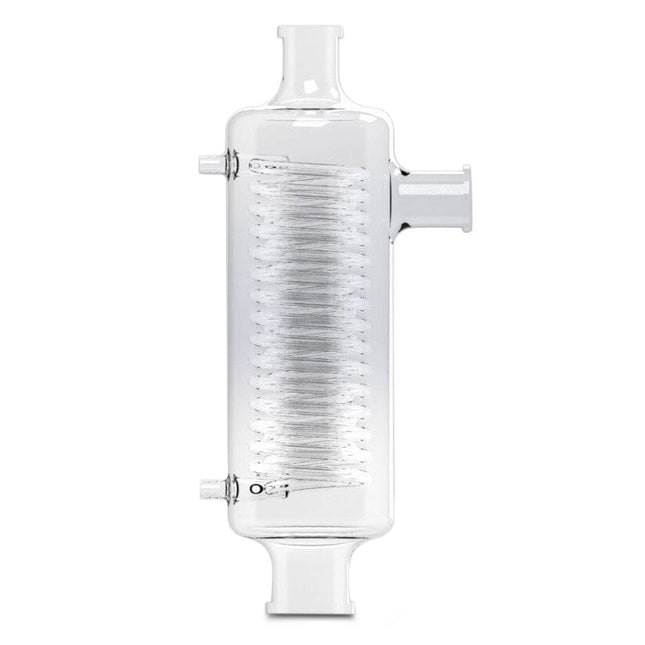
50L Auxiliary Condenser
Auxiliary condenser for 50L Best Value Rotary Evaporator. *Notice to customers: All units are inspected for broken glassware or parts before leaving BVV™. If the unit arrives damaged (this does not include minor imperfections or scuffs in glassware), the customer MUST contact BVV™ within 72 hours from carrier delivery to file a claim. If the customer DOES NOT contact BVV™ within 72 hours from carrier delivery, then BVV™ cannot issue any replacement(s) or compensation for the item; a new purchase will need to be made for a replacement. **Glassware Safety Disclaimer: BVV™ is not responsible for failure of glassware which must be inspected before and after every use because it may eventually develop imperfections or damage through normal usage, mishandling, and stress caused by temperature variations. If an imperfection or damage is noted while inspecting the glassware DO NOT use the glassware because it can fail causing bodily harm or damage to the surrounding area.**
$370.00
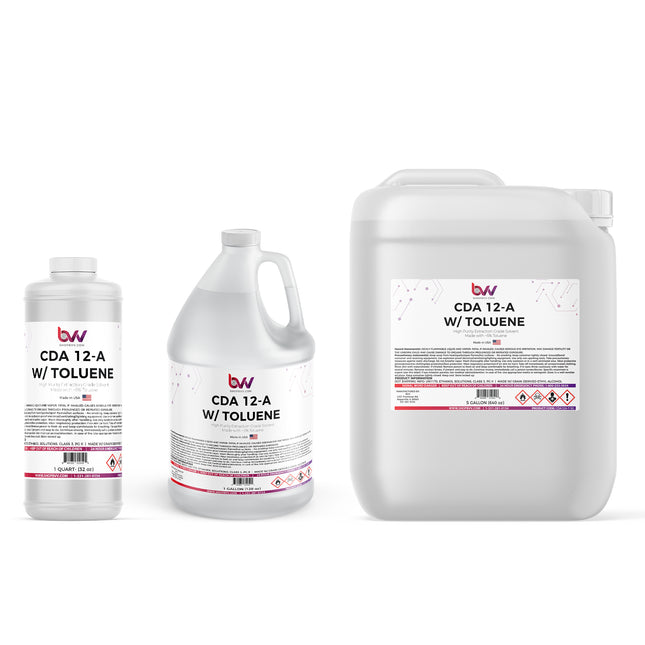
CDA 12A w/ Toluene High Purity Extraction Solvent
CDA 12A w/ Toluene HAZMAT ITEMS ARE NON-REFUNDABLE. ALL SALES ARE FINAL (Note: Container style and color may vary) BVV's Ultra High Purity Toluene Denatured Ethanol (CDA 12A) is distinguished by its exceptional purity, Our CDA 12A formulation combines 95% Food Grade/USP/ACS 200 Proof Ethanol, derived from corn, with ~5% high-purity Toluene. Adhering to stringent industry standards, ensuring it meets the precise requirements of our customers, our Ultra High Purity Toluene Denatured Ethanol excels across diverse applications widely adopted as an effective botanical extraction solvent. Being that our Ultra High Purity Denatured Ethanol is made unfit for consumption when denatured with Toluene it is not subject to the Federal Excise Tax on alcohol saving you a huge cost without compromising on it suitability for top-tier extractions. Primarily utilized as pure ethanol in extraction processes, this solvent is favored for its cost-effectiveness and extraction efficiency. Reduce manufacturing costs and increase extraction efficiency with BVV's Ultra High Purity Toluene Denatured Ethanol. Disclaimer: Prices may vary due to market value and for orders of 4 totes or more and a tanker there could be up to a 2 week lead time. Call in for more accurate lead times. Spigots/Faucets are only compatible with 5 Gallon Plastic Jugs and must be purchased separately Trigger Sprayer is only compatible with 1QT and 1 Gallon sizes Key Features: Significantly Reduced Cost due to the absence of Federal Tax Produces Exceptional Quality Extractions Leaves No Residuals or Tastes Evaporates Completely in a Rotary Evaporator Specifications Vapor Pressure: 40.9mmHg at 20°C UN Numbe 1170 Density: 0.7905g/cm³ Specific Gravity 0.7905 Flash Point: 13.9°C (57°F) Boiling Point: 78.5°C (173°F) Melting Point: -90.0°C (-130°F) Chemical Formula: Ethanol C2H6ON-Heptane C7H16 CAS#(s) Ethanol 64-17-5N-Heptane142-82-5 Chemical Formula: Ethanol C2H6ON-Heptane C7H16 Molecular Weight: 72.1057 CAS Registry Number: Ethanol 64-17-5N-Heptane142-82-5 Appearance Colorless Liquid Odor: Mint or acetone-like Density 0.7905g/cm³ Boiling Point: 78.5c/173.3F Solubility in water: Miscible GHS Pictograms: GHS Signal Word: Danger GHS Hazard Statements: H225, H319 GHS Precautionary Statements P210, P233, P240, P241, P242, P243, P261, P264, P271, P280, P303+P361+P353, P304+P340, P305+P351+P338, P312, P337+P313, P370+P378, P403+P233, P403+P235, P405, P501 UN Identification Number: 1987 Proper Shipping Name: Alcohols Transport Hazard Class: 3 Packing Group: I DOT Placard: What is Denatured Ethanol? Denatured ethanol, also known as denatured alcohol, is ethanol (ethyl alcohol) that has been rendered unfit for human consumption by the addition of denaturants. Denaturants are typically chemicals that make the ethanol taste bad or have toxic effects, and they are added to discourage people from drinking the substance. The denaturation process is done to avoid the high taxes and regulations associated with beverage alcohol, as denatured ethanol is intended for industrial, pharmaceutical, or cosmetic uses rather than for consumption. Common denaturants include heptane, methanol, isopropyl alcohol, acetone, and other chemicals. Denatured ethanol is widely used in various industries, such as in the production of paints, solvents, cleaning products, and as a fuel for alcohol burners. Why is Ethanol Denatured? Ethanol is denatured, or rendered undrinkable, for several reasons: Tax Purposes: Denaturing ethanol allows for the imposition of lower taxes on industrial or non-beverage alcohol compared to potable alcohol. Governments often place higher excise taxes on alcohol intended for human consumption. Regulatory Compliance: Denaturing ethanol is a regulatory requirement to discourage the illegal diversion of tax-free industrial alcohol for beverage use. The addition of denaturants makes it unpalatable and unsafe for consumption. Public Safety: Making ethanol undrinkable helps prevent accidental or intentional ingestion of industrial alcohol, which can be toxic. Denaturing agents are chosen to deter people from attempting to use denatured alcohol as a substitute for beverage alcohol. Industrial Use: Denatured ethanol is widely used in various industries, including pharmaceuticals, cosmetics, and manufacturing. It serves as a solvent, fuel, or raw material in these applications. Common denaturants include substances like heptane, methanol, isopropanol, and various chemicals that make the alcohol unsuitable for human consumption while maintaining its usability in industrial processes. The specific denaturing formulations, such as CDA 12-A mentioned earlier, are defined by regulatory agencies to ensure compliance with safety and tax regulations. What is denatured ethanol used for? Denatured ethanol is used for various industrial and commercial purposes where the alcohol is needed for its properties but should not be consumed. Here are some common applications: Industrial Solvent: Denatured ethanol is widely used as a solvent in industries such as pharmaceuticals, cosmetics, and manufacturing. It is effective in dissolving a variety of substances. Cleaning Agent: Due to its solvent properties, denatured ethanol is used as a cleaning agent for surfaces, equipment, and machinery in industrial and commercial settings. Fuel Additive: Denatured ethanol is sometimes used as a fuel additive, especially in the blending of gasoline. It can improve combustion efficiency and reduce emissions. Paint and Coating Industry: It is used as a solvent in the formulation of paints, varnishes, and coatings. Pharmaceuticals: Denatured ethanol is used in the pharmaceutical industry for various purposes, including the extraction of medicinal compounds. Laboratory Use: In laboratories, denatured ethanol is often used for tasks like sterilization and as a solvent for experiments. Inks and Dyes: It is employed in the production of inks and dyes due to its ability to dissolve pigments. Adhesives and Sealants: Denatured ethanol is used in the formulation of adhesives and sealants. Window Cleaning: It is used in commercial window cleaning solutions. Automotive Industry: In the automotive industry, denatured ethanol is used for cleaning and degreasing. What can be used to denature ethanol? Here are examples of common Completely Denatured Alcohol (CDA) formulations used to denature ethanol: CDA 12-A To every 100 gallons of alcohol, add either: Five gallons of n-heptane or 5 gallons of toluene. CDA-19 To every 100 gallons of ethyl alcohol (not less than 160 proof), add: 4.0 gallons of either methyl isobutyl ketone, mixed isomers of nitro propane, or methyln-butyl ketone 1.0 gallon of either kerosene, deodorized kerosene, gasoline, unleaded gasoline, rubber hydrocarbon solvent, or heptane. CDA-20 To every 100 gallons of ethyl alcohol (not less than 195 proof), add a total of: 2.0 gallons of either unleaded gasoline, rubber hydrocarbon solvent, kerosene, or deodorized kerosene, or any combination of these. What does CDA mean? Completely Denatured Alcohol (CDA) is a type of denatured alcohol that has been rendered unfit for human consumption by the addition of denaturing agents. Denatured alcohol is ethanol (ethyl alcohol) that has been intentionally adulterated to make it toxic, foul-tasting, or otherwise undrinkable. This denaturing process is done to exempt the alcohol from excise duty and other taxes, as it's not intended for use in beverages. The denaturing agents used in CDA can vary, but they often include chemicals such as methanol, isopropanol, or other substances that make the alcohol unpalatable and potentially harmful if ingested. The specific formulation of denatured alcohol may be regulated by government authorities to ensure it meets safety standards and legal requirements. CDA is commonly used in industrial applications, as a solvent, fuel, or as a cleaning agent. It's important to note that due to the addition of denaturing agents, CDA should not be used for purposes that involve contact with the human body or ingestion. Safety precautions, including proper ventilation, should be followed when working with denatured alcohol. What is CDA 12A? CDA 12-A is a formulation specified by the Alcohol and Tobacco Tax and Trade Bureau (TTB) for Completely Denatured Alcohol (CDA). The formula is defined under §21.26 as Formula No. 12-A. The composition of CDA 12-A is as follows: For every 100 gallons of alcohol, add either: 5 gallons of n-heptane or 5 gallons of toluene. This denaturing process renders the ethanol unfit for consumption while meeting regulatory requirements for various industrial applications. CDA formulations, including CDA 12-A, are used to denature ethanol for purposes such as industrial solvents, cleaning agents, and manufacturing processes. Can you remove heptane from CDA 12A? When n-Heptane is added to ethanol it creates an azeotrope between the ethanol and n-heptane. An azeotrope is defined as a mixture of two liquids that have a constant boiling point and composition through distillation. This azeotrope results in the ethanol and n-heptane evaporating at the same temperature, making it extremely difficult to separate the two through distillation. While these azeotropic solvents are still easily recovered from a botanical extract at a relatively low boiling point around 78C/173F using a rotary evaporator or falling film evaporator, it is near impossible to separate the two via distillation. What is an Azeotrope? An azeotrope is a mixture characterized by having identical concentrations in both its vapor and liquid phases. This stands in contrast to ideal solutions, where one component is usually more volatile than the other, allowing for separation through distillation. When an azeotrope forms, the concentrations in both phases remain the same, hindering separation through traditional distillation methods. Azeotropes consist of a blend of at least two different liquids, and this mixture can exhibit either a higher or lower boiling point than either of its individual components. Azeotropes become relevant when certain liquid fractions resist alteration through distillation processes. In typical mixtures, components can be extracted using Fractional Distillation, a process involving repeated distillation stages. The more volatile component vaporizes and is collected separately, while the less volatile component remains in the distillation container, resulting in two distinct, pure solutions.
$24.00 - $2,050.00
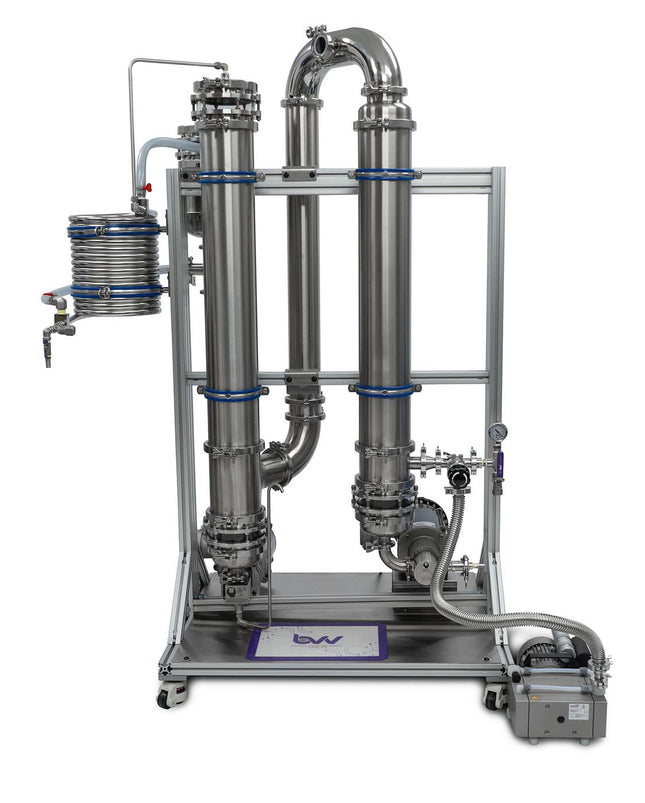
BVV 6" Falling Film Evaporator
BVV 6" Falling Film Evaporator Cutsheet Is your lab floor filled with a fleet of rotary evaporators? Looking to increase solvent recovery throughput? Our new and compact 20GPH Falling Film Evaporator (FFE) has the capability to maximize throughput and replace up to five 50L Rotary Evaporators. The BVV™ 20GPH Falling Film Evaporator is designed to evaporate ethanol that has been diluted in crude oil during a filtration or extraction process. By reducing the vapor pressure inside the system and metering the injection valve, the user can set the heat exchangers to the appropriate temperatures to efficiently evaporate solvent from their crude oil. We paired our FFE with reliable equipment that will keep operations running. End users are required to plumb the process inlet and outlet connections for both heat exchangers. They are supplied with 1.5” sanitary tri-clamp connections. BVV™ can assist with necessary parts needed for a permanent or temporary installation. Temporary installations may be necessary if your lab has limited fume hoods or space which is shared with other processing equipment. Below you will find key features, additional equipment included with the system and the power requirements for each, and real-life efficiencies that were tested. Key Features: · Compact rack design for use in fume hoods (39”x30”x75.5”) · Vernier scale metering valve for controlled injection · Accurate heater and chiller temperature control · Deep vacuum for effective solvent removal · Discharge pumps to eliminate constant reservoir draining and down time · Chemical resistant vacuum pump · Adaptable discharge outlets to customer preference · Insulation to limit thermal loses and reduce condensation (Not Pictured) · Sanitary tri-clamp and compression fittings · Pre-heat injection coil · Injection distribution plate · Tube in shell heat exchanger for efficient evaporation and condensation · Packable vapor path for reduction of contaminants and cleaner separation · Water reservoir for priming the heating system and expansion during operation Crude Discharge Pump Easily control discharge speed and collect your extract directly from the 3/8" tube via a collection vessel or swage on a fitting of your preference to pump collected extract to a secondary location. Eliminate constant reservoir draining and operate continuously. Metered Solvent Injection Effectively repeat efficiency and throughput with our vernier scale metering valve. Easy to dial in the desired efficiency and throughput desired by the user. Distribution Plate Directs the injected solvent to be evenly distributed across all tubes in the heat exchanger which maximizes the effective heating surface area. Solvent Discharge and Vacuum Pump The solvent discharge pump eliminates the need for a reservoir and allows you to pump recovered solvent to any desired secondary location. The vacuum pump manifold gives you easy vacuum control during the complete operation. POWER REQUIREMENTS The equipment listed below is included with the system. Check power requirements and amp draw prior to purchasing. Equipment Purpose Power Requirement Amp Draw Notes 2GPM Ethanol Recovery Pump for Vacuum Pump for Ethanol Recovery Discharge 230V 1-Phase 2.4 2GPM Max Flow Rate, Vacuum Check Valve Beaker and Wrench Explosion Proof Oil Pump Pump for Oil Recovery Discharge 230V 1-Phase 1.1 90L/hr. Max Flow Rate, Vacuum Check Valve Welch BTpro100 Diaphragm Pump Vacuum Pump for System 115 1-Phase 3.4 3.5 CFM, 6 Torr Ultimate Vacuum Total Amp Draw 6.9 EFFICIENCY We are proud to present real data with running parameters and efficiencies that reflect the actual operation of our system. Below you will find the tested throughputs and efficiencies that our FFE is capable of handling. Throughput 11 GPH 18 GPH 20 GPH 22 GPH 24 GPH Efficiency 98% 97% 94% 90% 85% ** Efficiency calculated at 10:1 ratio (Ethanol : Crude Oil) with heater temperature of 160°F. Crude is fully dewaxed when going into the falling film evaporator. Solution starts at room temperature. Speeds may differ based on dilution ratio, crude quality, and running parameters. **
$35,000.00
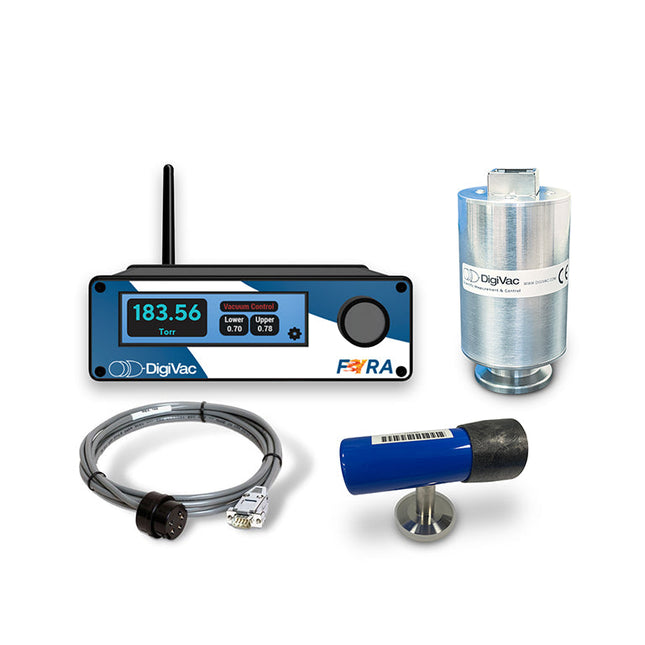
FYRA for End of Primary Drying Detection | Vacuum Drying Monitoring | for Lyophilization| CE, UL, CSA
FYRA for End of Primary Drying Detection. This bundle is set up to allow for vacuum drying applications like freeze-drying and vacuum ovens to help determine the end of drying. Will help you detect when most of the water or residual solvent from a product has been removed or the end of primary drying has been reached in a vacuum drying application. Background on How this FYRA End of Primary Drying package works: When a freeze dryer is equipped with both a thermal and direct measurement, these sensors can be utilized to indicate the end of primary drying (Source). Step One: Clean process documentation | Get a baseline Characterize the convection-enhanced Pirani and the capacitance manometer (in this case the DCP Quantum) against each other in a dry, empty and refrigerated system. The freeze dryer is turned on, as per the manufacturer’s operator manual, with nothing on the shelf. The shelf temperature can be left at room temperature, and if so the cold trap, the condenser, and the vacuum pump should be on and running for a period of time The vacuum oven or freeze dryer is allowed a period of time to become stable in this condition and the Pirani and capacitance manometers are read. The difference in their pressure readings in a dry, empty and refrigerated freeze dryer will be relatively small (mT to 10’s of mT) when the system is working properly. DigiVac will NOT calibrate these two gauges against each other. There may always be slight differences in their readings due to their difference in design. The difference in pressure (ΔP) between these two gauges, when dry, empty, and refrigerated, indicates how close they come together when there is little to no water vapor in the gas mix over the product. Step 2: Drying with Product The intent of primary drying is to maximize the sublimation rate within the product. As such the gases in the chamber have a high water vapor content. The Pirani sensor will read a higher pressure than the capacitance manometer. As freeze drying progresses the amount of ice converting to vapor through the sublimation process will decrease as the product becomes lyophilized from the top through the bottom of the product. Eventually, the Pirani and capacitance manometers will approach the ΔP that was established in a dry, empty and refrigerated system. Approaching this ΔP value indicates that the end of primary drying has occurred. The DigiVac FYRA controller has a rich remote command-line interface which enables the user a high degree of remote control and monitoring from any computer when communicating through the USB port. Calibrated—Every FYRA is calibrated and pretested under actual vacuum against a NIST standard (Need NIST traceable documentation? Add this option to your order) Applications—Ideal for End of Drying Detection, Freeze Drying Primary Drying Monitoring, and Vacuum Oven Drying Monitoring and Detection DCP Quantum DuoSense Measurement Range: .05 mT to 1000 Torr 275 Convection-enhanced Pirani Measurement Range: 0.1mT to 1000 Torr FYRA Bleed Vacuum Controller Components: FYRA controller Convection-enhance Pirani KF25 gauge sensor | Lesker 275, driver card, and Pirani sensor cable Quantum DCP Gauge and driver card | DuoSENS Capacitive Piezo Vacuum Sensor 0.01 to 1000 Torr, Gas Independent 3 Simple Steps for Vacuum Process Set-up with FYRA Vacuum Controller: Plumb the vacuum gauge(s) and valve into your vessel Connect the sensor, power, and I/O cables into FRYA Measure and control vacuum
$3,456.00
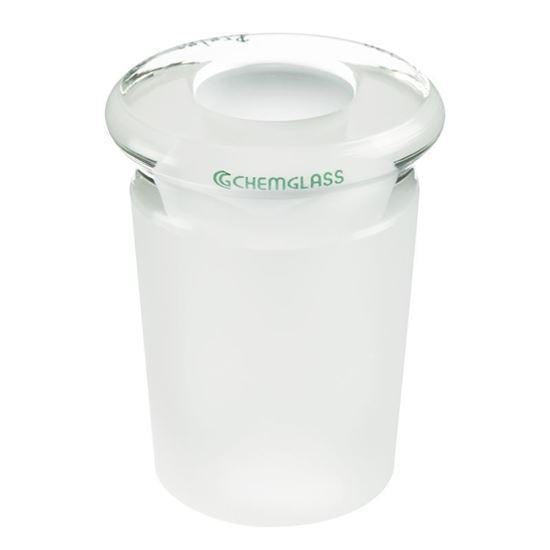
Chemglass Adapter, Bushing
Chemglass Adapter, Bushing Chemglass Bushing style adapter having a lower standard taper inner joint and outer joint ground in the bore of the adapter. Adapters having a 10/18 or 10/30 outer member in the bore are used to insert thermometers into apparatus. __________________________________________________________________________________________ ***Glassware Safety Disclaimer: BVV™ is not responsible for failure of glassware which must be inspected before and after every use because it may eventually develop imperfections or damage through normal usage, mishandling, and stress caused by temperature variations. If an imperfection or damage is noted while inspecting the glassware DO NOT use the glassware because it can fail causing bodily harm or damage to the surrounding area.*** ***All units are inspected for broken glass or parts before unit is shipped. If unit arrives damaged or glass is broken (this does not include minor imperfections or scuffs in glassware), Customer MUST contact BVV™ within 3 days of delivery to file a claim and receive a replacement part. If customer DOES NOT contact BVV™ within 3 days of delivery responsibility for replacement parts falls on the customer and they must pay for replacement pieces
$47.00$32.00
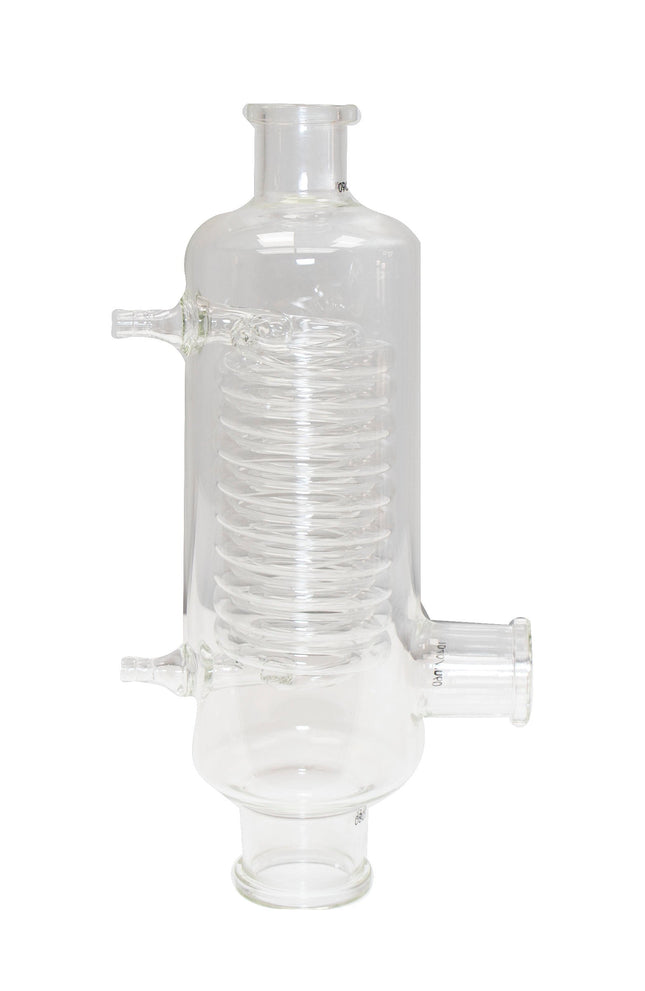
20L Solvent Pro Rotary Evaporator Auxiliary Condenser
20L Solvent Pro Rotary Evaporator Auxiliary Condenser Replacement Auxiliary Condenser for 20L Solvent Pro Rotary Evaporator
$360.00
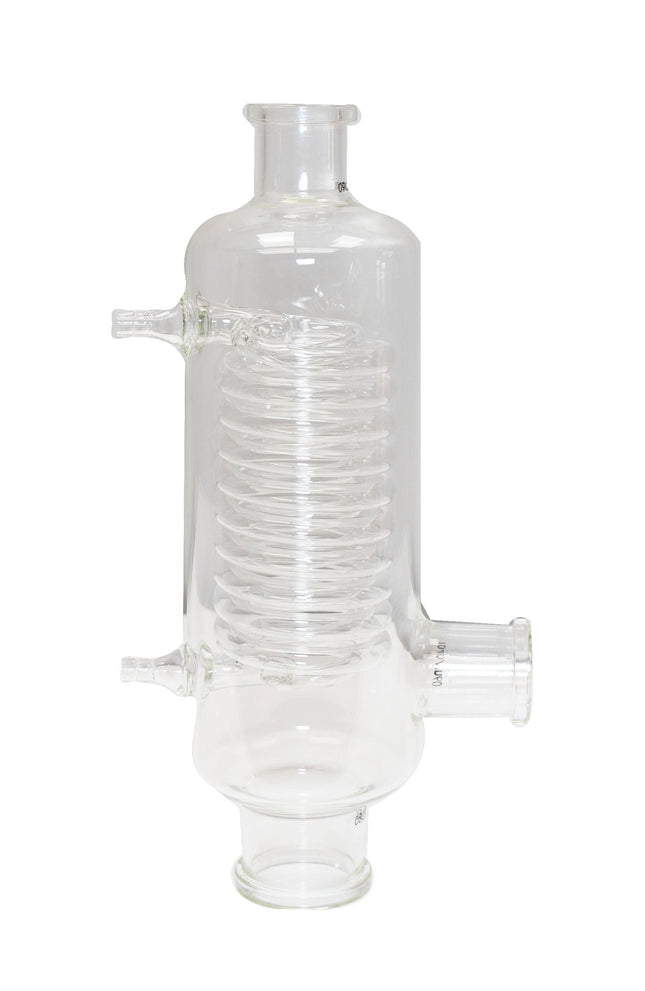
10L Solvent Pro Rotary Evaporator Auxiliary Condenser
10L Solvent Pro Rotary Evaporator Auxiliary Condenser Replacement Auxiliary Condenser for 10L Solvent Pro Rotary Evaporator
$284.00
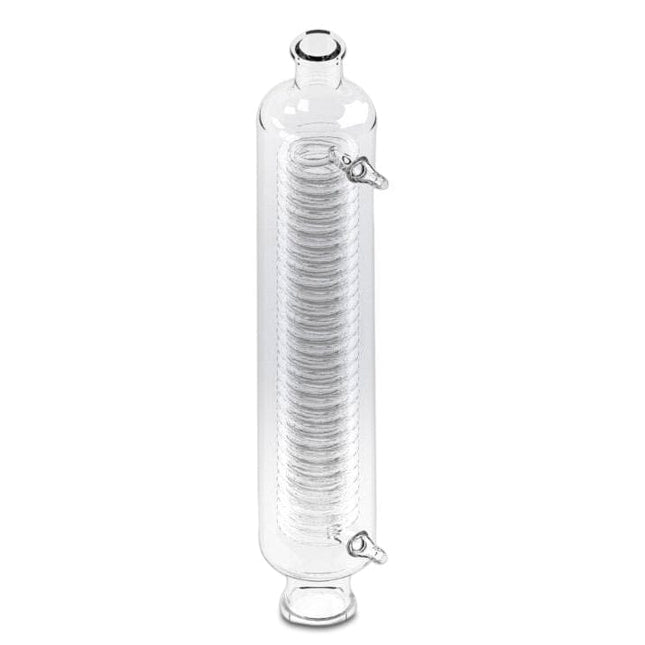
10L ECO Main Condenser
10L ECO Main Condenser This condenser is made to fit BVV rotary evaporators manufactured before 2019. The bottom port is a 60/80 joint to attach to the auxiliary condenser, and the top port is a 40/60 joint to connect to a vacuum connection.
$550.00
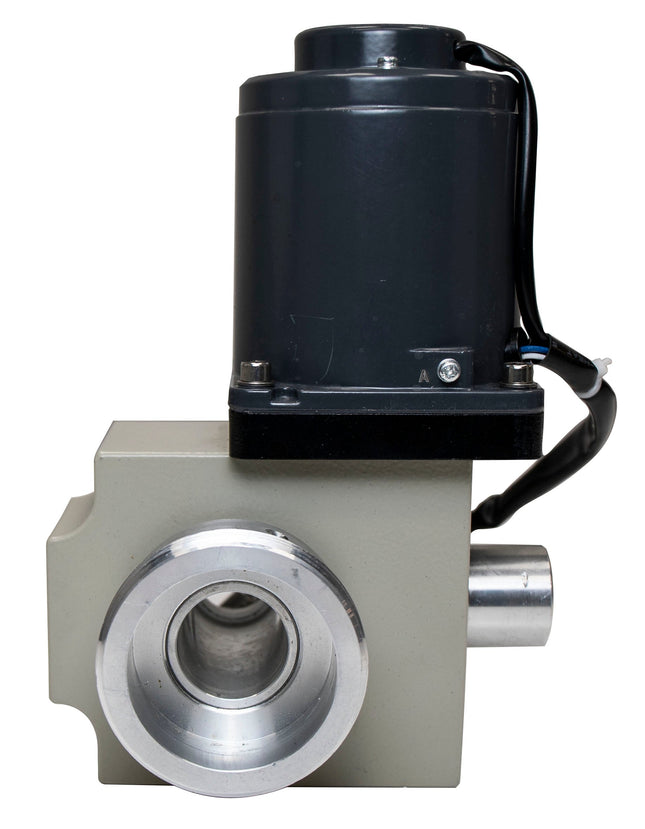
5L ECO V2 Rotary Evaporator Motor
5L ECO V2 Rotary Evaporator Motor This replacement motor fits on 5L rotary evaporators with manual lift baths. The controller connection must have the same 5 pin configuration as the plug shown in the pictures.
$450.00
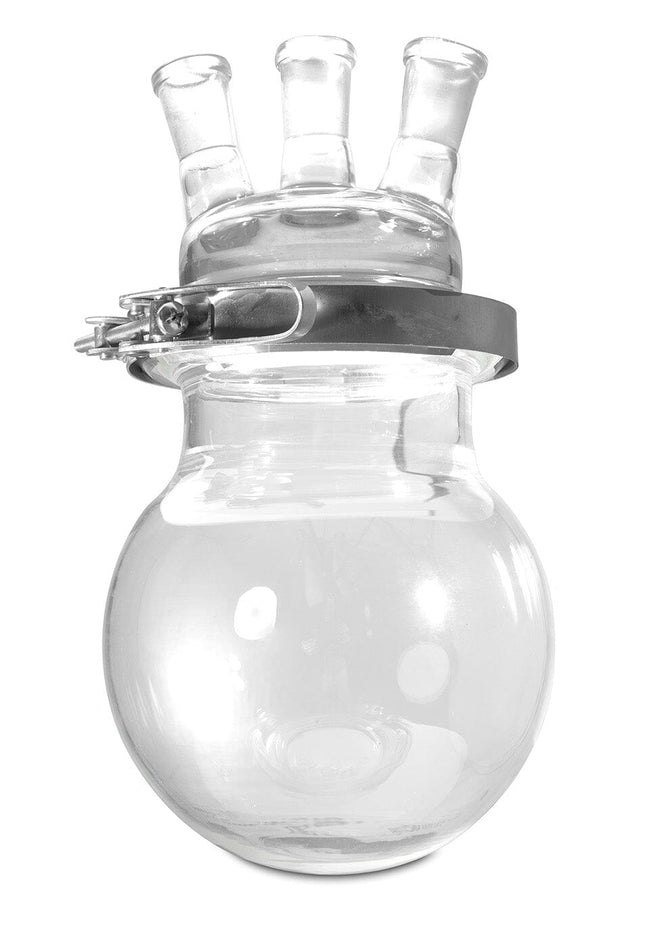
2 Liter BVV 3 - Neck Decarb Flask Kit
BVV 3 - Neck Decarb Flask Kit This 3 neck flask will fit in a 2L heating mantle. The flask can be used under vacuum but is ideal for use as a decarboxylation flask before running a short path setup. The lid has 3x 24/40 tapered glass joints.
$220.00$175.00
$600.00
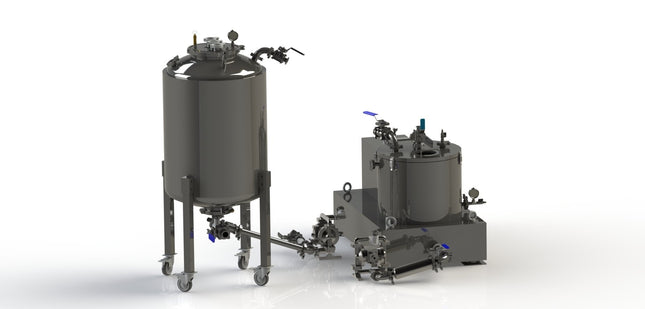
Room Temperature 45L Centrifuge Extractor Kit
Cryogenic 45L Centrifuge Extractor Kit EXPECT 3-WEEK LEADTIME Cryogenic 45L Centrifuge Extractor Kit Overview: The BVV Cryogenic 45L Centrifuge Extractor Kit is a modular closed loop alcohol extraction system with low temperature extraction in mind. It features low temperature rated (-60°C) components including PTFE envelope gaskets, pneumatic diaphragm pumps and cryogenic rated ball valves for longevity. The centrifuge controller and motor are EX rated and come with supporting documents making it easier to get approved for operation. Load centrifuge bags with 8-15lb (10lb avg.) biomass and line them up for an efficient extraction process. This system makes repeatability easier by letting the operator control extraction parameters including soak/agitation time, spin dry time, target alcohol temperature, and different pore material bags and filtration socks in our Pressure Filtration System (PFS). The system also allows operators to re-direct the first wash back to the holding vessel to re-chill if needed and go for a second extraction. This allows full use of alcohol’s extraction ability and minimize time spent recovering solvent in a rotary evaporator or falling film. Users will have to dial in their parameters and washes based on biomass potency. Low temperature extraction leads to less refinement after the extraction process. Inline PFS allows for fine particulate refinement down to 1µm. Higher potency will require further post processing for the removal of unwanted compounds. NOTE: CHILLER AND AIR COMPRESSOR NOT INCLUDED IN THE KIT. CALL IN FOR RECOMMENDED CHILLER AND AIR COMPRESSOR. Insulation: Insulation package is included with the order but does not come installed upon arrival. Insulation included are straight tubing, tees, and elbows. BVV can install insulation as an add on prior to shipping the system out. This will also include color coordinated zip ties that help assembly process. Assembly diagrams will also be included with the system. Installation requires taping seams cutting tubing to length, and zip tying tees and elbows. Holding vessel and centrifuge are vacuum insulated via the jacket. Supporting documents included: Standard Operating Procedure for CF45L-CRYO-01 Centrifuge Wiring Instructions CF45L-CRYO-01 Manual CF45L-CRYO-01 Assembly Diagram Centrifuge Controller EX Certificate Centrifuge Motor EX Certificate Pneumatic Pump specification sheet with operating pressure/flow chart CALL IN TO SCHEDULE A FULL PRESENTATION WITH ONE OF THE CRYOGENIC 45L CENTRIFUGE EXTRACT KIT. QUESTIONS CAN BE ANSWERED BY OUR ENGINEERING TEAM. Specifications Centrifuge Controller Power Requirements 220v 1PH 60Hz, 20A Circuit Liquid Transfer Pumps Pneumatic (Compressor Required) Drum Volume 45L Drum Dimensions 17.7" (450mm) Diameter x 11-7/8" (300mm) Deep Centrifuge Bags Included 1 of Ea: 1, 10, 50, 100, 200 Micron Max Biomass Capacity 15lbs (6.8Kg), Recommended 10lbs Solvent Capacity per Run 17 Gallons Centrifuge Speed 1500 RPM Centrifuge Weight 794lbs (360Kg) Overall System Dimensions 12'6" x 13'8" x 71" (3810mm x 4166mm x 1804mm) **with chiller next to system System Temperature Rating -60C (-76F) Material in Contact with Solvent and Extract PTFE envelope, Silicone, 304SS, BIIR(butyl) *FDA & USDA compliant Footprint: NOTE: CHILLER INCLUDED IN EXTRACTION SPACE WILL NEED TO BE APPROVED FOR USE IN C1D2 SPACE. AIR COMPRESSOR FOR PNEUMATIC PUMPS NOT INCLUDED IN DIAGRAM.
$29,500.00

Enclosed Motor Switch Hazardous-Location - UL Listed / CSA Certified for MVP Recovery Pumps
Enclosed Motor Switch Hazardous-Location - UL Listed / CSA Certified for MVP Recovery Pumps This motor switch is designed for hazardous environments where ignitable gas and dust may be present. They're rated NEMA 7 and 9 for hazardous locations. Use them to turn motors on and off, or with other circuits such as lighting and electric heat circuits. They do not provide overload protection. This item also includes a 1" Male x 3/4" Female NPSM bushing and 1/2" Pipe nipple for steel conduit. Specifications Switch Type Motor Control Reversing Capability Nonreversing Number of Circuits Controlled 2 Electrical Phase (hp) Single (3 hp @ 240 V AC) Switch Starting Position 2 Off (Normally Open) Switch Action Stays Switched (Maintained) Industry Designation DPST-NO Switching: Current 30 A Voltage 600V AC Housing: Material Painted Aluminum Color Gray Height 6.5" Width 3" Depth 4.3" Number of Mounting Holes 2 Mounting Hole Diameter 0.31" Mounting Fasteners Included No Wire Connection Type Screw Terminals Environment Hazardous Location Environment Rating NEMA 7, NEMA 9 Specifications Met UL Listed, CSA Certified RoHS Not Compliant REACH Not Compliant DFARS Specialty Metals COTS-Exempt Country of Origin Mexico
$400.00

Pre-Built 150L 304SS Jacketed Collection and Storage Vessel with 12" Tri-Clamp Port and Locking Casters
150L 304SS Jacketed Collection and Storage Vessel (Pre-Built 150L 304SS Jacketed Collection and Storage Vessel with 12" Tri-Clamp Port and Locking Casters) This massive 304 Stainless Steel Jacketed vessel can hold up to 150L of water (~40 gallons) and has a 12" Tri-Clamp port on the top and a 6" Tri-Clamp port on the bottom of the vessel. The outer jacket has 2x 1/2" FNPT ports to allow the circulation of heat transfer fluids and can also be used a vacuum jacket and can hold 21.5L or 5.68 gallons of fluid in the outer jacket. This unit also features 4 stainless steel legs with locking casters to allow the vessel to be moved around easily. Specifications Material 304 Stainless Steel Connection Type(s): 12" Tri-Clamp Top Ports 6" Tri-Clamp Bottom Port (2) 1/2" FNPT Ports ***Note: This item will ship via freight ONLY.
$3,500.00

P10 BVV™ Distillation Head - USA Made
P10 BVV™ Distillation Head P10 Distillation Head has 2 sets of vigreux in the distillation column with 45/50 lower joint, 24/40 Thermometer Joint, and 34/45 side joint and includes GL-14 barb connections. MADE IN THE USA Designed for 10 Liter Flasks Set of 2 vigreux to allow for more packing media Larger vacuum jacket allows for less heat loss during distillations Larger vapor path to allow for gas/vapor phase flow Increased internal diameter for faster, more efficient fractioning as well as packing and unpacking of media Increased condenser length and diameter for more efficient condensation of vapor with zero clogging *Notice to customers: All units are inspected for broken glassware or parts before leaving BVV™. If the unit arrives damaged (this does not include minor imperfections or scuffs in glassware), the customer MUST contact BVV™ within 72 hours from carrier delivery to file a claim. If the customer DOES NOT contact BVV™ within 72 hours from carrier delivery, then BVV™ cannot issue any replacement(s) or compensation for the item; a new purchase will need to be made for a replacement. **Glassware Safety Disclaimer: BVV™ is not responsible for failure of glassware which must be inspected before and after every use because it may eventually develop imperfections or damage through normal usage, mishandling, and stress caused by temperature variations. If an imperfection or damage is noted while inspecting the glassware DO NOT use the glassware because it can fail causing bodily harm or damage to the surrounding area.**
$800.00
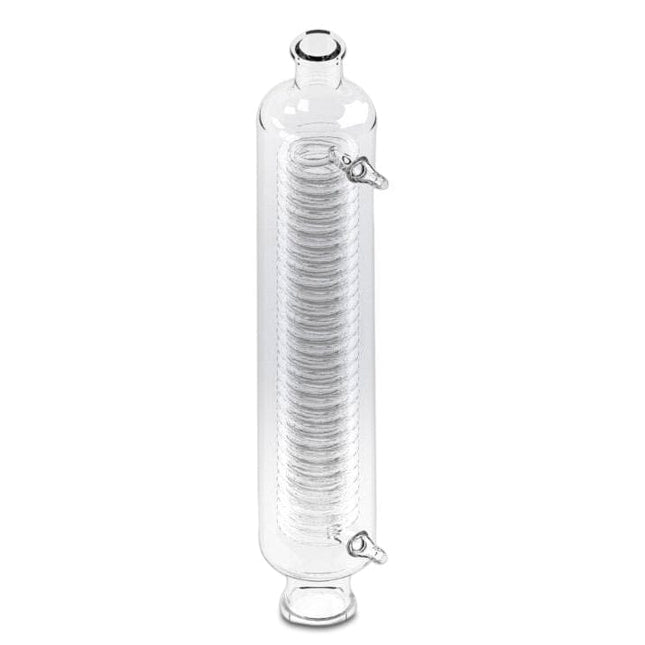
20L Main Condenser
20L Main Condenser Big port- 60/79 Small port- 41/59
$500.00
You have seen 787 out of 787 products



















